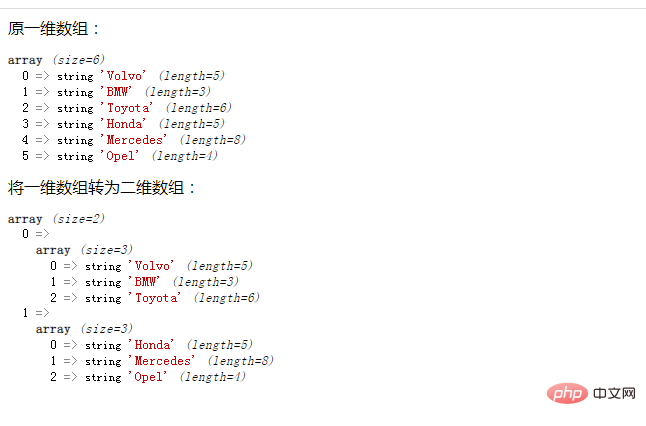 Backend Development
Backend Development
 PHP Problem
PHP Problem
 How to convert one-dimensional array to two-dimensional array in php
How to convert one-dimensional array to two-dimensional array in php
How to convert one-dimensional array to two-dimensional array in php
In PHP, you can use the array_chunk() function to convert a one-dimensional array into a two-dimensional array. The function of this function is to split the array. It can split an array into multiple array blocks; the syntax format is "array_chunk ($arr,count($arr)/2)".

The operating environment of this tutorial: windows7 system, PHP7.1 version, DELL G3 computer
In php, you can use array_chunk () function to convert a one-dimensional array into a two-dimensional array.
Example:
<?php
header("Content-type:text/html;charset=utf-8");
$arr=array("Volvo","BMW","Toyota","Honda","Mercedes","Opel");
echo "原一维数组:";
var_dump($arr);
$chunk=array_chunk($arr,count($arr)/2);
echo "将一维数组转为二维数组:";
var_dump($chunk);
?>
Explanation:
array_chunk() function can To split an array into multiple array blocks, the syntax is as follows:
array array_chunk ( array $arr , int $size [, bool $preserve_keys = false ] )
Parameter description:
arr represents the array to be split;
size represents the number of elements of the divided sub-array;
preserve_keys represents whether to retain the original key names in the arr array. The default is false, that is, not retained, split Each subsequent sub-array will use a new numeric index starting from 0; if set to true, the original key names in arr will be retained.
array_chunk() will split the arr array into multiple sub-arrays, and the number of elements in each sub-array is determined by size. The last subarray may have less than size elements.
Return value: Returns a multi-dimensional array composed of divided sub-arrays.
Recommended learning: "PHP Video Tutorial"
The above is the detailed content of How to convert one-dimensional array to two-dimensional array in php. For more information, please follow other related articles on the PHP Chinese website!

Hot AI Tools

Undresser.AI Undress
AI-powered app for creating realistic nude photos

AI Clothes Remover
Online AI tool for removing clothes from photos.

Undress AI Tool
Undress images for free

Clothoff.io
AI clothes remover

AI Hentai Generator
Generate AI Hentai for free.

Hot Article

Hot Tools

Notepad++7.3.1
Easy-to-use and free code editor

SublimeText3 Chinese version
Chinese version, very easy to use

Zend Studio 13.0.1
Powerful PHP integrated development environment

Dreamweaver CS6
Visual web development tools

SublimeText3 Mac version
God-level code editing software (SublimeText3)

Hot Topics
 1377
1377
 52
52
 PHP 8.4 Installation and Upgrade guide for Ubuntu and Debian
Dec 24, 2024 pm 04:42 PM
PHP 8.4 Installation and Upgrade guide for Ubuntu and Debian
Dec 24, 2024 pm 04:42 PM
PHP 8.4 brings several new features, security improvements, and performance improvements with healthy amounts of feature deprecations and removals. This guide explains how to install PHP 8.4 or upgrade to PHP 8.4 on Ubuntu, Debian, or their derivati
 CakePHP Date and Time
Sep 10, 2024 pm 05:27 PM
CakePHP Date and Time
Sep 10, 2024 pm 05:27 PM
To work with date and time in cakephp4, we are going to make use of the available FrozenTime class.
 Discuss CakePHP
Sep 10, 2024 pm 05:28 PM
Discuss CakePHP
Sep 10, 2024 pm 05:28 PM
CakePHP is an open-source framework for PHP. It is intended to make developing, deploying and maintaining applications much easier. CakePHP is based on a MVC-like architecture that is both powerful and easy to grasp. Models, Views, and Controllers gu
 CakePHP File upload
Sep 10, 2024 pm 05:27 PM
CakePHP File upload
Sep 10, 2024 pm 05:27 PM
To work on file upload we are going to use the form helper. Here, is an example for file upload.
 CakePHP Creating Validators
Sep 10, 2024 pm 05:26 PM
CakePHP Creating Validators
Sep 10, 2024 pm 05:26 PM
Validator can be created by adding the following two lines in the controller.
 How To Set Up Visual Studio Code (VS Code) for PHP Development
Dec 20, 2024 am 11:31 AM
How To Set Up Visual Studio Code (VS Code) for PHP Development
Dec 20, 2024 am 11:31 AM
Visual Studio Code, also known as VS Code, is a free source code editor — or integrated development environment (IDE) — available for all major operating systems. With a large collection of extensions for many programming languages, VS Code can be c
 CakePHP Quick Guide
Sep 10, 2024 pm 05:27 PM
CakePHP Quick Guide
Sep 10, 2024 pm 05:27 PM
CakePHP is an open source MVC framework. It makes developing, deploying and maintaining applications much easier. CakePHP has a number of libraries to reduce the overload of most common tasks.
 How do you parse and process HTML/XML in PHP?
Feb 07, 2025 am 11:57 AM
How do you parse and process HTML/XML in PHP?
Feb 07, 2025 am 11:57 AM
This tutorial demonstrates how to efficiently process XML documents using PHP. XML (eXtensible Markup Language) is a versatile text-based markup language designed for both human readability and machine parsing. It's commonly used for data storage an



